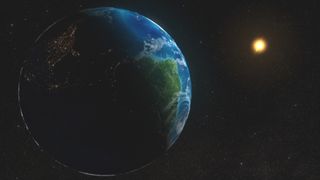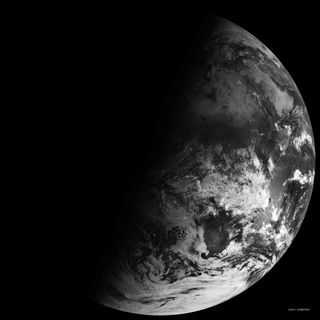Planet Earth is having its annual close encounter of the stellar kind this weekend.
There's nothing unusual about the planet being a little closer to the sun; it's a normal occurrence that happens near the start of the calendar year. Earth travels in an elliptical orbit, so its distance from the sun changes throughout its 365.25 day journey. (Side note: the quarter days are what prompt a leap year every four years.)
Earth reaches perihelion — the term for its closest approach to the sun — on Sunday (Jan. 5) at 2:48 a.m. EST (0748 GMT), according to EarthSky.org. For those living on the U.S. West Coast, the moment occurs on Jan. 4 at 11:48 p.m. PST. Half a year later, on July 4, Earth will reach aphelion — its most distant point from the sun.
Related: The 100 Best Space Photos of 2019

At the time of perihelion, Earth is about 91,398,199 miles (147,091,144 kilometers) away from the sun. On average, Earth's distance from the sun is 92,955,807 miles (149,597,870 km). When our planet reaches aphelion in July, it will be 94,507,635 miles (152,095,295 km) away.
Earth doesn't feel warmer for the Northern Hemisphere when perihelion occurs. That's because the ellipse in which our planet orbits is not extreme, but almost circular. The cause of seasonal changes is the tilt in the planet's axis. Perihelion and aphelion don't cause the seasons, but they do affect the length of the seasons.
This is something like what Earth experiences during this time of year. The planet's close approach to the sun causes it to travel slightly faster. The faster trip means a short duration for winter in the Northern Hemisphere and summer in the Southern Hemisphere, according to EarthSky.org. Thus, winters in the Northern Hemisphere are about five days shorter than the summer, and summers in the Southern Hemisphere are five days shorter than winter.

But again, the seasons are controlled by Earth's tilted axis, not its distance from the sun.
"The sun is the big controller of the radiation that the Earth receives," Walter Petersen, a research physical scientist in the Earth science branch at NASA's Marshall Space Flight Center, told Space.com in 2018. "But even when you take into account that difference in distance between aphelion and perihelion, there's only about a 7 percent difference in average global [solar energy] that we receive. And so it doesn't amount to a great deal in terms of weather."
Follow Doris Elin Urrutia on Twitter @salazar_elin. Follow us on Twitter @Spacedotcom and on Facebook.

"Planet" - Google News
January 05, 2020 at 08:05PM
https://ift.tt/39FnqUh
Happy Perihelion Day 2020! Earth Is Closest to the Sun Today - Space.com
"Planet" - Google News
https://ift.tt/2Qdey0Y
Shoes Man Tutorial
Pos News Update
Meme Update
Korean Entertainment News
Japan News Update
Bagikan Berita Ini














0 Response to "Happy Perihelion Day 2020! Earth Is Closest to the Sun Today - Space.com"
Post a Comment